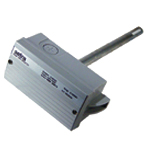As we have talked about in our Importance of Measuring Humidity post, accurate humidity measurement is crucial. Building owners must be sure to maintain and monitor humidity levels for occupants' comfort and safety. Improper humidity measurement can put a building at risk for mold and other airborne pathogens which can lead to sick building syndrome.
There are three types of mounts for humidity sensors; wall mount, duct mount or outdoor air. In order to operate correctly with a long life expectancy, it is vital that the sensor is properly mounted and placed. Proper mounting requires careful consideration to ensure the sensor meets your needs. Here is a guide on how to place three types of humidity sensors:
- Mount the sensor in a location where it can be exposed to an unrestricted air circulation that is representative of the average humidity and/or temperature of the environment
- Mount the sensor on an indoor wall approximately 4-6 feet above the floor
- Avoid locations where excessive moisture, fumes, vibration, or high ambient temperatures devices (portable electric heaters, coffee makers, computers, copy machines) are present
Duct Mount Sensor
- Mount the sensor so that the sensor probe is in the center of the duct
- Make sure it is away from fans, corners, heating and cooling coils, dampers and other equipment that will affect the measurement of relative humidity
- The mounting location should receive adequate air flow for proper operation
- Since the typical duct system has an outdoor air intake, the contaminants associated with the outdoor air may have an effect on a sensors frequency, so the sensor should be recalibrated regularly
- RH sensors in a duct system should be checked on an annual basis
Outdoor Air Mount Sensor
 The mounting location should be in a sheltered area that is protected from rain
The mounting location should be in a sheltered area that is protected from rain- Ideally, the sensor should be located on the north-side of the building (under an eave) to prevent sun-heated air from rising up the building's wall and affecting the relative humidity of the sensor
- Pay particular attention to the location of heat-generating condensing units and building vent & fan exhausts. The heated air and possible contaminants associated with building exhaust could influence the sensors accuracy and could possibly contaminate the sensor element, requiring premature replacement of the unit
CLICK HERE to learn about Setra's humidity sensors.




